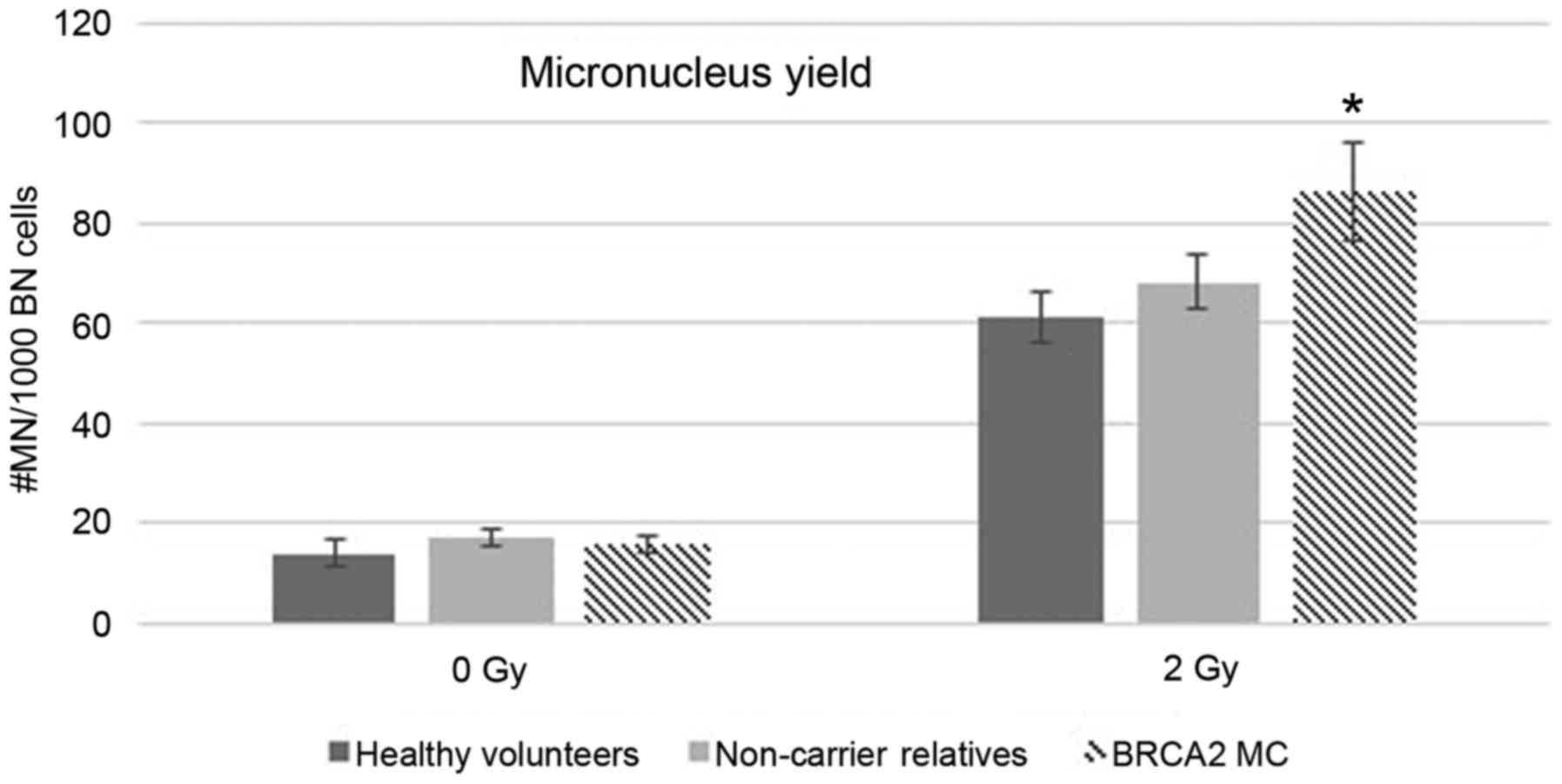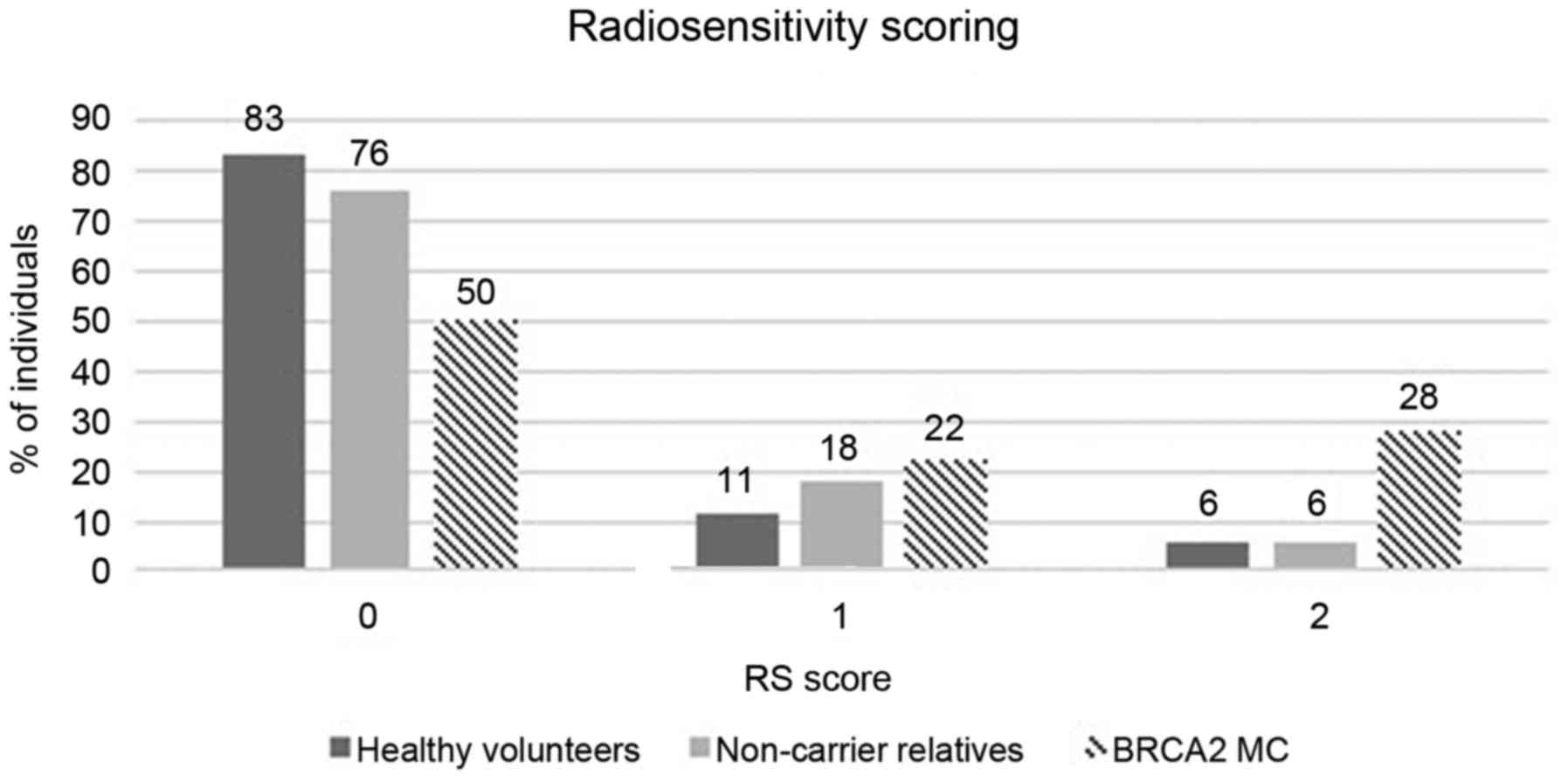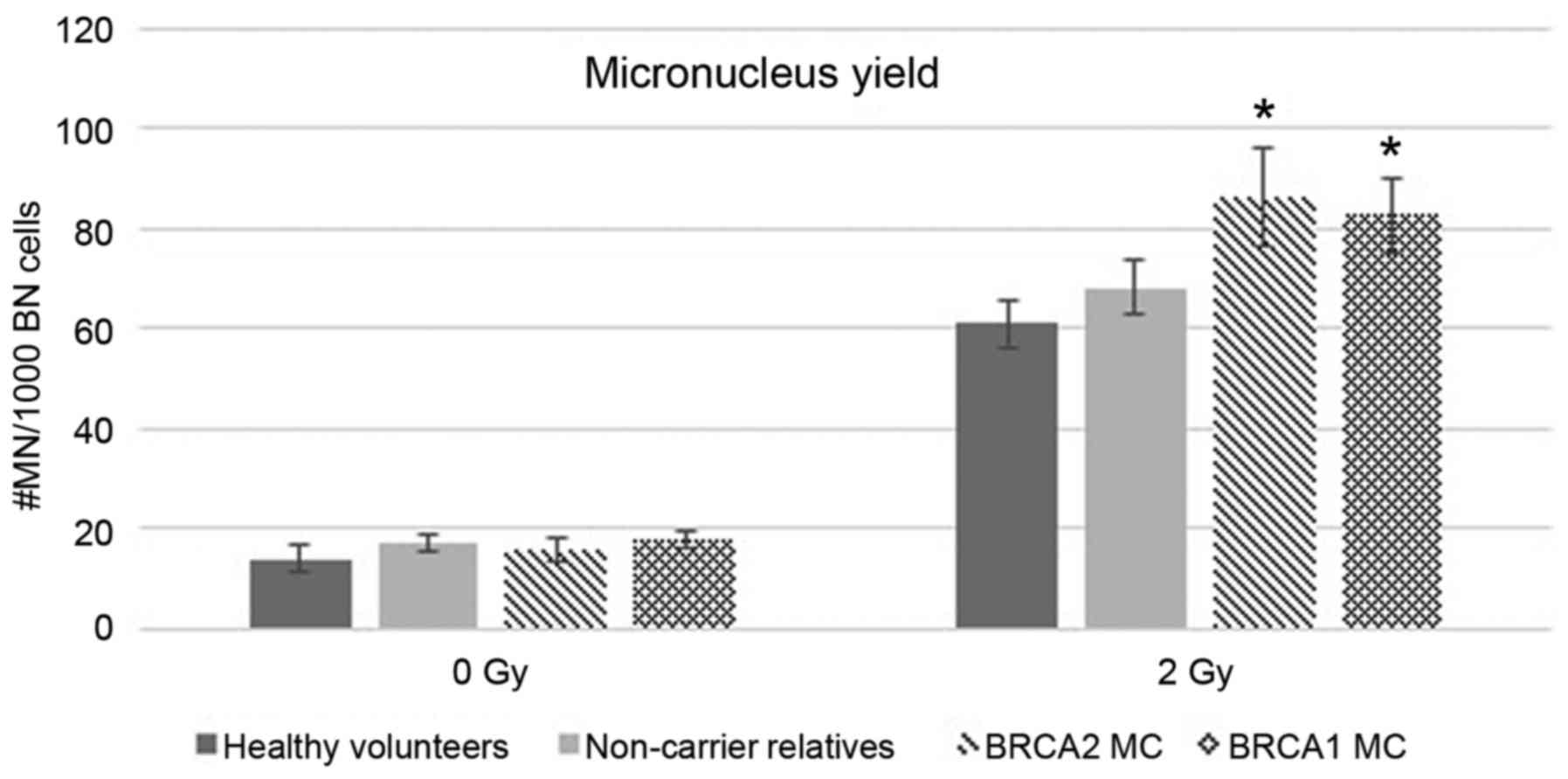|
1
|
Roy R, Chun J and Powell SN: BRCA1 and
BRCA2: Different roles in a common pathway of genome protection.
Nat Rev Cancer. 12:68–78. 2011. View Article : Google Scholar : PubMed/NCBI
|
|
2
|
Bernholtz S, Laitman Y, Kaufman B,
Shimon-Paluch S and Friedman E: Phenocopy breast cancer rates in
Israeli BRCA1 BRCA2 mutation carrier families: Is the risk
increased in non-carriers? Breast Cancer Res Treat. 132:669–673.
2012. View Article : Google Scholar : PubMed/NCBI
|
|
3
|
Domchek SM, Gaudet MM, Stopfer JE,
Fleischaut MH, Powers J, Kauff N, Offit K, Nathanson KL and Robson
M: Breast cancer risks in individuals testing negative for a known
family mutation in BRCA1 or BRCA2. Breast Cancer Res Treat.
119:409–414. 2010. View Article : Google Scholar : PubMed/NCBI
|
|
4
|
Harvey SL, Milne RL, McLachlan SA,
Friedlander ML, Birch KE, Weideman P, Goldgar D, Hopper JL and
Phillips KA: kConFab Investigators: Prospective study of breast
cancer risk for mutation negative women from BRCA1 or BRCA2
mutation positive families. Breast Cancer Res Treat. 130:1057–1061.
2011. View Article : Google Scholar : PubMed/NCBI
|
|
5
|
Korde LA, Mueller CM, Loud JT, Struewing
JP, Nichols K, Greene MH and Mai PL: No evidence of excess breast
cancer risk among mutation-negative women from BRCA
mutation-positive families. Breast Cancer Res Treat. 125:169–173.
2011. View Article : Google Scholar : PubMed/NCBI
|
|
6
|
Kurian AW, Gong GD, John EM, Johnston DA,
Felberg A, West DW, Miron A, Andrulis IL, Hopper JL, Knight JA, et
al: Breast cancer risk for noncarriers of family-specific BRCA1 and
BRCA2 mutations: Findings from the Breast Cancer Family Registry. J
Clin Oncol. 29:4505–4509. 2011. View Article : Google Scholar : PubMed/NCBI
|
|
7
|
Nielsen HR, Petersen J, Krogh L, Nilbert M
and Skytte AB: No evidence of increased breast cancer risk for
proven noncarriers from BRCA1 and BRCA2 families. Fam Cancer.
15:523–528. 2016. View Article : Google Scholar : PubMed/NCBI
|
|
8
|
Smith A, Moran A, Boyd MC, Bulman M,
Shenton A, Smith L, Iddenden R, Woodward ER, Lalloo F, Maher ER, et
al: Phenocopies in BRCA1 and BRCA2 families: Evidence for modifier
genes and implications for screening. J Med Genet. 44:10–15. 2007.
View Article : Google Scholar : PubMed/NCBI
|
|
9
|
Vos JR, De Bock GH, Teixeira N, van der
Kolk DM, Jansen L, Mourits MJE and Oosterwijk JC: Proven
non-carriers in BRCA families have an earlier age of onset of
breast cancer. Eur J Cancer. 49:2101–2106. 2013. View Article : Google Scholar : PubMed/NCBI
|
|
10
|
Evans DGR, Ingham SL, Buchan I, Woodward
ER, Byers H, Howell A, Maher ER, Newman WG and Lalloo F: Increased
rate of phenocopies in all age groups in BRCA1/BRCA2 mutation
kindred, but increased prospective breast cancer risk is confined
to BRCA2 mutation carriers. Cancer Epidemiol Biomarkers Prev.
22:2269–2276. 2013. View Article : Google Scholar : PubMed/NCBI
|
|
11
|
Pijpe A, Andrieu N, Easton DF, Kesminiene
A, Cardis E, Noguès C, Gauthier-Villars M, Lasset C, Fricker JP,
Peock S, et al: GENEPSO; EMBRACE; HEBON: Exposure to diagnostic
radiation and risk of breast cancer among carriers of BRCA1/2
mutations: Retrospective cohort study (GENE-RAD-RISK). BMJ.
345:e56602012. View Article : Google Scholar : PubMed/NCBI
|
|
12
|
Baert A, Depuydt J, Van Maerken T, Poppe
B, Malfait F, Storm K, van den Ende J, Van Damme T, De Nobele S,
Perletti G, et al: Increased chromosomal radiosensitivity in
asymptomatic carriers of a heterozygous BRCA1 mutation. Breast
Cancer Res. 18:522016. View Article : Google Scholar : PubMed/NCBI
|
|
13
|
Andrieu N, Easton DF, Chang-Claude J,
Rookus MA, Brohet R, Cardis E, Antoniou AC, Wagner T, Simard J,
Evans G, et al: Effect of chest X-rays on the risk of breast cancer
among BRCA1/2 mutation carriers in the international BRCA1/2
carrier cohort study: A report from the EMBRACE, GENEPSO,
GEO-HEBON, and IBCCS Collaborators' Group. J Clin Oncol.
24:3361–3366. 2006. View Article : Google Scholar : PubMed/NCBI
|
|
14
|
Lecarpentier J, Noguès C, Mouret-Fourme E,
Stoppa-Lyonnet D, Lasset C, Caron O, Fricker JP, Gladieff L, Faivre
L, Sobol H, et al: GENEPSO: Variation in breast cancer risk with
mutation position, smoking, alcohol, and chest X-ray history, in
the French National BRCA1/2 carrier cohort (GENEPSO). Breast Cancer
Res Treat. 130:927–938. 2011. View Article : Google Scholar : PubMed/NCBI
|
|
15
|
Narod SA, Lubinski J, Ghadirian P, Lynch
HT, Moller P, Foulkes WD, Rosen B, Kim-Sing C, Isaacs C, Domchek S,
et al: Hereditary Breast Cancer Clinical Study Group: Screening
mammography and risk of breast cancer in BRCA1 and BRCA2 mutation
carriers: A case-control study. Lancet Oncol. 7:402–406. 2006.
View Article : Google Scholar : PubMed/NCBI
|
|
16
|
Giannakeas V, Lubinski J, Gronwald J,
Moller P, Armel S, Lynch HT, Foulkes WD, Kim-Sing C, Singer C,
Neuhausen SL, et al: Mammography screening and the risk of breast
cancer in BRCA1 and BRCA2 mutation carriers: A prospective study.
Breast Cancer Res Treat. 147:113–118. 2014. View Article : Google Scholar : PubMed/NCBI
|
|
17
|
Goldfrank D, Chuai S, Bernstein JL, Ramon
Y, Cajal T, Lee JB, Alonso MC, Diez O, Baiget M, Kauff ND, Offit K,
et al: Effect of mammography on breast cancer risk in women with
mutations in BRCA1 or BRCA2. Cancer Epidemiol Biomarkers Prev.
15:2311–2313. 2006. View Article : Google Scholar : PubMed/NCBI
|
|
18
|
John EM, McGuire V, Thomas D, Haile R,
Ozcelik H, Milne RL, Felberg A, West DW, Miron A, Knight JA, et al:
Kathleen Cuningham Foundation Consortium for Research into Familial
Breast Cancer (kConFab); Whittemore AS: Diagnostic chest X-rays and
breast cancer risk before age 50 years for BRCA1 and BRCA2 mutation
carriers. Cancer Epidemiol Biomarkers Prev. 22:1547–1556. 2013.
View Article : Google Scholar : PubMed/NCBI
|
|
19
|
Bernstein JL, Thomas DC, Shore RE, Robson
M, Boice JD Jr, Stovall M, Andersson M, Bernstein L, Malone KE,
Reiner AS, et al: WECARE Study Collaborative Group: Contralateral
breast cancer after radiotherapy among BRCA1 and BRCA2 mutation
carriers: A WECARE study report. Eur J Cancer. 49:2979–2985. 2013.
View Article : Google Scholar : PubMed/NCBI
|
|
20
|
Baeyens A, Thierens H, Claes K, Poppe B,
de Ridder L and Vral A: Chromosomal radiosensitivity in BRCA1 and
BRCA2 mutation carriers. Int J Radiat Biol. 80:745–756. 2004.
View Article : Google Scholar : PubMed/NCBI
|
|
21
|
Gutiérrez-Enríquez S, Ramón Y, Cajal T,
Alonso C, Corral A, Carrasco P, Cornet M, Sanz J, Ribas M, Baiget M
and Diez O: Ionizing radiation or mitomycin-induced micronuclei in
lymphocytes of BRCA1 or BRCA2 mutation carriers. Breast Cancer Res
Treat. 127:611–622. 2011. View Article : Google Scholar : PubMed/NCBI
|
|
22
|
Trenz K, Rothfuss A, Schütz P and Speit G:
Mutagen sensitivity of peripheral blood from women carrying a BRCA1
or BRCA2 mutation. Mutat Res. 500:89–96. 2002. View Article : Google Scholar : PubMed/NCBI
|
|
23
|
Beroukas E, Pandis N, Giannoukakos K,
Rizou E, Beroukas K, Giatromanolaki A and Koukourakis M: Increased
chromosomal radiosensitivity in women carrying BRCA1/BRCA2
mutations assessed with the G2 assay. Int J Radiat Oncol Biol Phys.
76:1199–1205. 2010. View Article : Google Scholar : PubMed/NCBI
|
|
24
|
Becker AA, Graeser MK, Landwehr C, Hilger
T, Baus W, Wappenschmidt B, Meindl A, Weber RG and Schmutzler RK: A
24-color metaphase-based radiation assay discriminates heterozygous
BRCA2 mutation carriers from controls by chromosomal
radiosensitivity. Breast Cancer Res Treat. 135:167–175. 2012.
View Article : Google Scholar : PubMed/NCBI
|
|
25
|
Bolognesi C, Bruzzi P, Gismondi V, Volpi
S, Viassolo V, Pedemonte S and Varesco L: Clinical application of
micronucleus test: A case-control study on the prediction of breast
cancer risk/susceptibility. PLoS One. 9:e1123542014. View Article : Google Scholar : PubMed/NCBI
|
|
26
|
Cardinale F, Bruzzi P and Bolognesi C:
Role of micronucleus test in predicting breast cancer
susceptibility: A systematic review and meta-analysis. Br J Cancer.
106:780–790. 2012. View Article : Google Scholar : PubMed/NCBI
|
|
27
|
Claes K, Depuydt J, Taylor AMR, Last JI,
Baert A, Schietecatte P, Vandersickel V, Poppe B, De Leeneer K,
D'Hooghe M, et al: Variant ataxia telangiectasia: Clinical and
molecular findings and evaluation of radiosensitive phenotypes in a
patient and relatives. Neuromolecular Med. 15:447–457. 2013.
View Article : Google Scholar : PubMed/NCBI
|
|
28
|
Menzel T, Nähse-Kumpf V, Kousholt AN,
Klein DK, Lund-Andersen C, Lees M, Johansen JV, Syljuåsen RG and
Sørensen CS: A genetic screen identifies BRCA2 and PALB2 as key
regulators of G2 checkpoint maintenance. EMBO Rep. 12:705–712.
2011. View Article : Google Scholar : PubMed/NCBI
|
|
29
|
Keimling M, Volcic M, Csernok A, Wieland
B, Dörk T and Wiesmüller L: Functional characterization connects
individual patient mutations in ataxia telangiectasia mutated (ATM)
with dysfunction of specific DNA double-strand break-repair
signaling pathways. FASEB J. 25:3849–3860. 2011. View Article : Google Scholar : PubMed/NCBI
|
|
30
|
Arnold K, Kim MK, Frerk K, Edler L,
Savelyeva L, Schmezer P and Wiedemeyer R: Lower level of BRCA2
protein in heterozygous mutation carriers is correlated with an
increase in DNA double strand breaks and an impaired DSB repair.
Cancer Lett. 243:90–100. 2006. View Article : Google Scholar : PubMed/NCBI
|
|
31
|
Perrin-Vidoz L, Sinilnikova OM,
Stoppa-Lyonnet D, Lenoir GM and Mazoyer S: The nonsense-mediated
mRNA decay pathway triggers degradation of most BRCA1 mRNAs bearing
premature termination codons. Hum Mol Genet. 11:2805–2814. 2002.
View Article : Google Scholar : PubMed/NCBI
|
|
32
|
Anczuków O, Ware MD, Buisson M, Zetoune
AB, Stoppa-Lyonnet D, Sinilnikova OM and Mazoyer S: Does the
nonsense-mediated mRNA decay mechanism prevent the synthesis of
truncated BRCA1, CHK2, and p53 proteins? Hum Mutat. 29:65–73. 2008.
View Article : Google Scholar : PubMed/NCBI
|
|
33
|
Berger AH, Knudson AG and Pandolfi PP: A
continuum model for tumour suppression. Nature. 476:163–169. 2011.
View Article : Google Scholar : PubMed/NCBI
|
|
34
|
Guidugli L, Pankratz VS, Singh N, Thompson
J, Erding CA, Engel C, Schmutzler R, Domchek S, Nathanson K, Radice
P, et al: A classification model for BRCA2 DNA binding domain
missense variants based on homology-directed repair activity.
Cancer Res. 73:265–275. 2013. View Article : Google Scholar : PubMed/NCBI
|
|
35
|
Willems P, Claes K, Baeyens A,
Vandersickel V, Werbrouck J, De Ruyck K, Poppe B, van den Broecke
R, Makar A, Marras E, et al: Polymorphisms in nonhomologous
end-joining genes associated with breast cancer risk and
chromosomal radiosensitivity. Genes Chromosomes Cancer. 47:137–148.
2008. View Article : Google Scholar : PubMed/NCBI
|
|
36
|
Guo Z, Shu Y, Zhou H, Zhang W and Wang H:
Radiogenomics helps to achieve personalized therapy by evaluating
patient responses to radiation treatment. Carcinogenesis.
36:307–317. 2015. View Article : Google Scholar : PubMed/NCBI
|
|
37
|
Popanda O, Marquardt JU, Chang-Claude J
and Schmezer P: Genetic variation in normal tissue toxicity induced
by ionizing radiation. Mutat Res. 667:58–69. 2009. View Article : Google Scholar : PubMed/NCBI
|
|
38
|
Antoniou AC, Kuchenbaecker KB, Soucy P,
Beesley J, Chen X, McGuffog L, Lee A, Barrowdale D, Healey S,
Sinilnikova OM and et al; CIMBA: SWE-BRCA; HEBON; EMBRACE; GEMO
Collaborators Study; kConFab Investigators: Common variants at
12p11, 12q24, 9p21, 9q31.2 and in ZNF365 are associated with breast
cancer risk for BRCA1 and/or BRCA2 mutation carriers. Breast Cancer
Res. 14:R332012. View Article : Google Scholar : PubMed/NCBI
|
|
39
|
Claes K, Poppe B, Machackova E, Coene I,
Foretova L, DePaepe A and Messiaen L: Differentiating pathogenic
mutations from polymorphic alterations in the splice sites of BRCA1
and BRCA2. Genes Chromosomes Cancer. 37:314–320. 2003. View Article : Google Scholar : PubMed/NCBI
|












